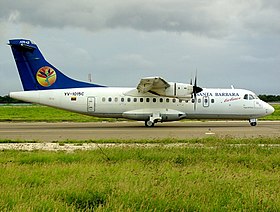Santa Barbara Airlines Flight 518
| Santa Barbara Airlines Flight 518 | |
|---|---|
|
An identical machine of the type ATR 42-300 from Santa Bárbara Airlines |
|
| Accident summary | |
| Accident type | Controlled flight into terrain |
| place | Mountains near Mérida, Venezuela |
| date | February 21, 2008 |
| Fatalities | 46 |
| Survivors | 0 |
| Aircraft | |
| Aircraft type |
|
| operator |
|
| Mark |
|
| Departure airport |
Mérida Airport , Venezuela |
| Destination airport |
Simón Bolívar Airport , Caracas Venezuela |
| Passengers | 43 |
| crew | 3 |
| Lists of aviation accidents | |
The Santa Bárbara Airlines flight 518 (flight number: S3518 ) was a scheduled domestic flight of the Venezuelan airline Santa Bárbara Airlines from Mérida Airport to Simón Bolívar Airport in Caracas . On February 21, 2008, an ATR 42-300 had an accident on this flight , killing all 46 people on board.
Until the accident of another machine of this type on Trigana Air Service Flight 257 in 2015, it was the worst incident involving an ATR 42.
plane
The aircraft affected was an ATR 42-300, a model of the Italian-French consortium Avions de Transport Régional (ATR) founded by Aeritalia and Aérospatiale for the construction of regional aircraft . The machine was 21 years and 3 months old at the time of the accident. It had the model serial number 28, was finally assembled at the ATR production site in Toulouse in 1986 and made its maiden flight on October 22, 1986. The machine was delivered on November 13, 1986 to Simmons Airlines , which operated flights with ATR machines under the brand name American Eagle . The machine received the aircraft registration N422MQ . On August 21, 1998 the machine returned to ATR , where it was temporarily given the F-WQIO registration . In March 2001 the machine was leased to the Cuban Aerogaviota , where it was in operation as CU-T1452 , before it returned to its manufacturer on February 15, 2002 with the aircraft registration F-WQNG . From August 1, 2002, the aircraft was leased as PR-TTC to Total Linhas Aéreas from Brazil , before it was taken over by Santa Bárbara Airlines on October 28, 2005 as YV1449 . The twin-engine regional airliner was with two turboprop engines of the type Pratt & Whitney Canada PW120 equipped.
Passengers and crew
There was a three-person crew on board, consisting of a captain, first officer and a flight attendant. The 36-year-old flight captain Aldino Garanito Gomez was a long-time pilot and test captain of the airline and had over 5000 hours of flight experience. First officer was the 29-year-old Denis Ferreira Quintal. For the flight to Caracas , 43 passengers were seated in the plane. The crew and most of the passengers were Venezuelan citizens, but there were also five Colombian and one US citizen among the passengers.
| nationality | Passengers | crew | total |
|---|---|---|---|
|
|
37 | 3 | 40 |
|
|
5 | - | 5 |
|
|
1 | - | 1 |
| total | 43 | 3 | 46 |
Flight plan
Since the university town of Mérida , a popular tourist destination , is located high in the Andes and surrounded by mountain ranges, night flights from Alberto Carnevalli Airport are prohibited. With its departure time at 5:00 p.m. local time, Flight 518 was the last commercial flight to depart from the airport that day.
the accident
Shortly after take-off, the machine was flown just below the summit of a 4000 meter high mountain massif, which is popularly known as the “Indian face” (Spanish: La Cara del Indio). Before the impact, air traffic control in Mérida had not received any emergency reports from the pilots, which is why it was initially impossible to understand how the accident could have happened.
Accident investigation
After evaluating the accident data memory, it was provisionally announced on July 28, 2008 that the navigation systems were not operational when departing from Mérida, as a result of which the pilots lost their bearings while flying through the mountainous area near the airport. While they were trying to determine their position, they flew the machine into a mountainside just a few meters below the summit.
In the accident report, the failure to use or incorrect use of the checklists before departure was stated as one of the causes of the accident. As a result, the Attitude and Heading Reference System (AHRS) was not initialized before the take-off run. Although the pilots noticed during the take-off run that the AHRS was out of order, they cockily decided to continue the take-off. A synchronization of the system would have taken a waiting time of 30 seconds. Due to the non-functional AHRS, the pilots were unable to maintain their flight course and lost their orientation when flying through the cloud cover.
There were several delays prior to departure. Among other things, the pilots had forgotten the time during a coffee break in the terminal. When they found out that the passengers had already been boarded, they rushed to the plane and tried to make up for the lost time. The extremely hectic flight crew had intentionally flown an unofficial abbreviation that deviated from the official departure procedure in order to save time.
swell
- Aircraft accident report in the Aviation Safety Network
- Operating history of the machine on planespotters.net
- Recording the voice recorder
Coordinates: 8 ° 39 ′ 33 " N , 71 ° 14 ′ 17" W.
